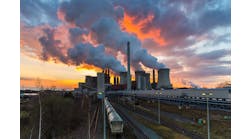Environmental Protection: Net Zero Efforts Add Up
The experiences of Solvay, BASF and Chemours illustrate how chemical companies are refining their strategies to reduce carbon dioxide (CO2) emissions and, ultimately, become carbon neutral, i.e., have net zero emissions. All aspects of production, from energy generation to global supply chains, are under the spotlight.
Solvay sets out its roadmap in its Solvay One Planet initiative. Here, the Brussels, Belgium-based company outlines strategies to achieve full carbon neutrality by 2040 for all its businesses other than soda ash. By 2050, Solvay expects the entire company to attain neutrality.
The plan contains decade-by-decade goals. Efforts from 2020–2030 will focus on reducing carbon dioxide from energy use and process emissions. Then, 2030–2040 will see energy transition projects including electrification, new energy technologies and process innovations. Finally, initiatives in 2040–2050 will tackle the company’s “hard-to-abate” soda ash sites via as yet undefined new technologies and energy sources. As part of this overall strategy, Solvay will use offsets for up to 1 million tons of CO2, primarily through nature-based offsetting programs in partnership with nongovernmental organizations.
“Solvay plans to invest up to €1 billion (≈$1.1 billion) across all of our businesses, with the exception of the soda ash business, to achieve carbon neutrality by 2040. Specifically for the soda ash business, Solvay plans to provide another €1 billion (≈$1.1 billion) of identified investments through 2040 to pave its path towards full carbon neutrality for the group before 2050,” explains Pascal Chalvon, chief sustainability officer.
This decade, the company already has launched 36 emissions-reduction projects based on energy use, together reducing CO2 emissions by 2.5 million mt/y. Including projects designed to reduce process emissions, Solvay expects to cut CO2 emissions by 3.7 million mt/y by the end of the decade.
“The success of these early projects has prompted Solvay to upgrade its greenhouse gas [GHG] emissions reduction target from -26% to -30% by 2030,” Chalvon adds.
Specific Projects
Chalvon cites a contract just signed with a local agricultural cooperative to supply biomethane to its plant at Melle, France, as an example of efforts. The cooperative has built a facility to convert waste biomass into 18 GWh/y of energy, which Solvay will purchase as part of its strategy to decarbonize its cyclopentanone unit at Melle. That plant manufactures two grades of cyclopentanone, one for the fragrance market and an ultra-high purity version for the electronics market.
“The same approach now is going to be extended to other sites in Solvay’s aroma business, such as our Saint-Fons facility in Lyon,” he notes.
The company also is undertaking three major cleaner-energy projects within its soda ash business. One, at its largest European soda ash plant in Devnya, Bulgaria, involves adapting an existing boiler to increase the amount of biomass it can co-combust to 30%. The biomass will come from a variety of sources including locally sourced sunflower husk pellets. When the upgraded boiler begins operating in November of this year, CO2 emissions related to energy production will fall by 20%.
Similarly, a project in Rheinberg, Germany, should make the company’s soda ash plant there (Figure 1) the world’s first to be powered primarily by renewable energy.
Figure 1. Project in Germany aims to make the unit the world’s first such plant powered primarily by renewable energy. Source: J. Kefferpuetz, Solvay Deutschland.
Meanwhile, refuse-derived fuel (RDF) alone will power a cogeneration plant at the Dombasle soda ash site in France. Two furnaces that will consume 350,000 mt/y of RDF and generate 181 MW of thermal power and 17.5 MW of electrical power will replace three coal-fired boilers. They should begin operation in 2024, and will reduce emissions of CO2 from the plant by 50%.
Together, these three projects in Europe will cut the group's emissions globally by 8% by 2025.
“The investment focus for the soda ash business is in the energy transition of our plants around the world from coal power to more-sustainable forms of energy. We will also continually improve processes and technologies to make operations as sustainable as possible,” stresses Chalvon.
In terms of economics, Solvay doesn’t provide a breakdown on how it will split its investments between energy-transition and process-optimization projects. However, Chalvon says they will generate returns well in excess of the cost of capital, with some funds coming from asset-specific financing — enabling the company to continue to invest in its growth areas.
“Furthermore, in 2021 we raised Solvay’s internal carbon price from €50 to €100/mt of CO2 [≈$55–110], thereby ensuring that future investments are oriented towards zero-emission projects. This is therefore input as a cost for every investment project we undertake, allowing us to accelerate our coal exit projects,” he explains.
The company is keen to embrace other initiatives that will help meet its commitments, and in the autumn of 2020 joined the Science-Based Targets initiative (SBTi). Founded in 2015, the SBTi helps companies align their GHG emission targets with what climate science shows is required to prevent catastrophic climate change. The organization currently has over 2,500 members.
The SBTi categorizes direct and indirect emissions into three broad scopes: Scope 1 for direct GHG emissions from sources owned or controlled by the company; Scope 2 for indirect GHGs emissions from consumption of purchased electricity, heat or steam; and Scope 3 for other indirect emissions, such as the extraction and production of purchased materials and fuels, outsourced activities and waste disposal.
“The next step for Solvay will be to have our Scope 3 targets finalized by the SBTi later this year. As we continue to advance on our sustainability targets, we certainly expect to continue raising the bar across all three pillars of our Solvay One Planet roadmap: climate, resources and better life,” states Chalvon.
He also points to the importance of working with individual governments and local authorities on specific projects. For example, regional investment from the Île-de-France and Nouvelle Aquitaine regions is complementing existing European Union funding toward a new research-and-development pilot line in La Rochelle, France, for advanced inorganic materials used in solid-state batteries. The French state also is providing backing for a €300-million (≈$330-million) capacity expansion at Solvay’s polyvinylidene fluoride (PVDF) facility in Tavaux. PVDF is an essential component in electric batteries, too.
Special Team
BASF, Ludwigshafen, Germany, also constantly is investigating ways to improve its sustainability strategies, which include a commitment to cut emissions by 25% by 2030 compared with 2018 and to become climate neutral by 2050.
Its latest initiative, which launched in January, is the Net Zero Accelerator unit. Based at Ludwigshafen, that group is charged with bundling together all of BASF’s activities relating to low-CO2 production technologies, the circular economy and renewable energies.
Led by Lars Kissau, senior vice president, global strategic business development petrochemicals, Net Zero Accelerator reports directly to BASF’s company chairman. The unit’s initial 80 employees were recruited from in-house experts.
“Net Zero Accelerator is a distinct and cohesive organizational unit and not just a ‘virtual’ arrangement. All employees now work in a well-coordinated and -orchestrated way under one roof, and additional colleagues are being recruited internally and externally,” notes a BASF spokesperson.
Existing initiatives, such as ChemCycling (see: “How Industry Tackles Plastics Plague”) and methane pyrolysis, are part of the Net Zero Accelerator unit, which currently is focused on scaling up these and other new technologies in the run-up to 2030 before possible commercialization later.
For example, BASF is developing methane pyrolysis technology for the CO2-free production of hydrogen from natural gas. A pilot plant in Ludwigshafen started up several months ago. Funding for this project was provided by the German Federal Ministry of Education and Research.
Figure 2. BASF, Linde and SABIC are working towards a 2023 start-up of pilot unit. Source: BASF.
Together with SABIC and Linde, BASF is working to develop a pilot furnace for the world’s first electrically heated steam cracker (Figure 2). Compared to conventional crackers, it would enable nearly CO2-free production of basic chemicals. If the necessary funding is granted shortly, the pilot plant could start-up as soon as 2023.
“Some projects and technologies in the scope of Net Zero Accelerator are already ready for commercialization and specific announcements will follow once investment decisions have been taken. Other projects and technologies still require further development. For these, we expect a contribution to our CO2-reduction targets at a later point in time,” adds the spokesperson.
The Net Zero Accelerator unit’s purview also includes BASF Renewable Energy, which is responsible for initiating new projects to generate renewable energy and to negotiate long-term power purchase agreements with energy producers.
Already underway are several such projects, including the acquisition of a 49.5% stake in Vattenfall’s 1.5-GW Hollandse Kust Zuid wind farm, and a 25-y contract to purchase 186 MW of capacity from Ørsted’s planned Borkum Riffgrund 3 offshore wind farm in the German North Sea.
The unit is reviewing or has initiated other major projects for the generation of electricity from renewable sources in Europe, Asia and the Americas.
“Besides renewable energy from offshore wind farms, we also focus on large-scale solar. For example, together with [German regional energy supplier] enviaM, we have started the construction of a 24-MWp solar park in Schwarzheide, Germany,” notes the spokesperson.
Sustainable Supply Chains
Chemours, Wilmington, Del., has become the 33rd chemical company to join the Together for Sustainability (TfS) initiative, Brussels, Belgium. TfS, https://tfs-initiative.com, was set up to drive and foster resilience, efficiency and sustainability in the chemical industry’s global supply chains.
Chemours’ own global procurement function involves hundreds of staff and a multi-billion-dollar budget covering everything from energy and gas to transportation services and real estate.
“2020 and 2021 proved to be unprecedented in terms of relentless and impactful supply chain issues. We learned a lot about vulnerabilities and have made substantial progress in assessing risk and developing mitigation plans,” notes chief procurement officer (CPO) Michelle Moore.
A key benefit of TfS membership is the ability to collaborate with like-minded procurement professionals in a common industry, says Moore. “In the brief time we’ve been a member, I have heard CPOs speak of challenges that are remarkably like what we’re facing and experiences they have had that will help us avoid similar pitfalls.”
To encourage this cross-pollination of data and information, TfS members conduct audits of suppliers. These reports then are shared with both the suppliers and other TfS members. “As a result, we expect improved quality of assessment and audits, and, of course, we all save time and effort through sharing audit and assessment results,” adds Moore.
She also is working alongside Chemours’ own chief sustainability officer to develop a new vision for responsible procurement.
“A major shift we’re making is to embed responsible procurement into our daily work, to drive collective ownership and responsibility for achieving our goals,” she stresses.
To help achieve this, the company has drawn together a global eight-member responsible procurement team tasked with taking part in regional TfS networks and developing and driving the company’s priority programs.
“Our focus is embedding responsible procurement across our team so that they can drive sustainability at every level and function within Chemours and in our supplier management process. We are looking at it holistically and integrating sustainability criteria in our supplier qualification and performance management processes. To drive ownership at the manager level, we are rewriting our role descriptions to include sustainability aspects as important KPIs, such as quality and cost,” she explains.
Success is measured by how well the company can improve the business sustainability score it gets from EcoVadis, https://ecovadis.com — Chemours has received silver certification for two years in a row — and how well responsible procurement ingrains itself in the organization’s culture.
“We’re also keen on expanding our supplier reach, so we’re tracking the increasing number of suppliers we’ve assessed. Our membership with TfS should help us move faster in both regards,” declares Moore.
While TfS is largely CPO focused, workstreams and regional networks within the organization attract other expertise. One, for example, is devoted to Scope 3 GHG emissions.
“This workstream is of great interest to Chemours to support our climate objectives. So I would not box the work of TfS to only ‘procurement-related issues.’ We are focused on sustainability issues, too.”
Chemours’ current goal is to achieve a 60% reduction in Scope 1 and 2 GHG emissions by 2030. It aims to reach net-zero GHG emissions by 2050.
“We belong to many other external forums and networks, and with that may come some great leveraging ideas,” Moore concludes.
Seán Ottewell is Chemical Processing's editor at large. You can email him at [email protected].





